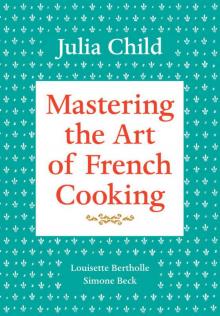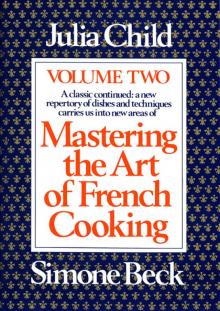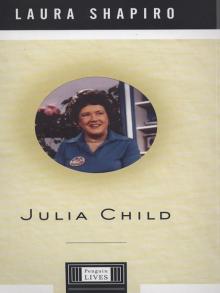- Home
- Julia Child
Mastering the Art of French Cooking, Volume 1 Page 40
Mastering the Art of French Cooking, Volume 1 Read online
Page 40
2 Tb softened butter
A warmed sauceboat
Off heat, and just before serving, add the butter by bits, swirling the sauce in the casserole until each addition has been absorbed. Ladle a spoonful of sauce and vegetables over the meat. Pour the rest into the warmed sauceboat.
VEAU PRINCE ORLOFF
[Veal Gratinéed with Onions and Mushrooms]
This delicious creation is fine for a party as it may be prepared in the morning and reheated in the evening. The veal is cooked and sliced, re-formed with a spreading of onions and mushrooms between each slice, and covered with a light cheese sauce. It is reheated and browned before serving. Braised lettuce or endive go particularly well with this roast, and either a red Bordeaux wine from the Médoc district or a chilled white Burgundy.
For 10 to 12 people
Roasting the veal
A 5-lb. boned and tied roast of veal
Brown the veal, and roast it for about 2½ hours (to 175 degrees on a meat thermometer) in a covered casserole as described in the master recipe, this page. Then allow the meat to rest for 30 minutes at room temperature; it will be carved when the preparations which follow are ready.
A 1-quart saucepan
Strain the roasting juices into the saucepan and skim off fat. Boil juices down rapidly to reduce to 1 cup. They will go into your velouté sauce later.
While the veal is roasting, prepare the onions and mushrooms as follows:
Soubise (rice and onions)
¼ cup raw white rice
2 quarts boiling water
1 Tb salt
Drop the rice into boiling salted water. Boil 5 minutes. Drain.
3 Tb butter
A 6- to 8-cup, heavy, fireproof casserole with cover
1 lb. (3½ cups) sliced yellow onions
½ tsp salt
Melt the butter in the casserole, stir in the onions and salt, and coat well with butter; stir in the rice. (No liquid is added; the onions provide enough for the rice.) Cover and cook over very low heat or in the oven next to the veal for 45 minutes to 1 hour, until the rice and onions are very tender but not browned.
Mushroom duxelles
½ lb. finely minced fresh mushrooms (makes 2 cups)
3 Tb minced shallots or green onions
2 Tb butter
1 Tb oil
An 8-inch enameled skillet or heavy-bottomed enameled saucepan
Salt and pepper
A handful at a time, squeeze the mushrooms in the corner of a towel to extract their juice. Then sauté them with the shallots or onions in hot butter and oil for 5 to 6 minutes, or until the pieces begin to separate from each other. Season to taste and set aside.
When the roast is done, prepare the following sauce and the filling:
Thick velouté sauce
6 Tb butter
A 2-quart, heavy-bottomed enameled saucepan
8 Tb flour
A wooden spoon
3 cups boiling liquid: the veal-roasting juices plus milk
A wire whip
Pinch of nutmeg
¼ tsp salt
⅛ tsp pepper
Melt the butter in the saucepan. Stir in the flour and cook slowly together, stirring, until they foam for 2 minutes without coloring. Remove from heat, pour in all the boiling liquid at once and beat vigorously with wire whip. Beat in the seasonings. Bring to the boil, stirring, and boil for 1 minute. Correct seasoning. Sauce will be very thick.
½ cup whipping cream
Pour 1 cup of sauce into the cooked rice and onions. Beat the cream into the rest of the sauce and set it in a pan of simmering water to continue cooking slowly.
Rice, onion, and mushroom filling
The cooked rice and onions
The mushroom duxelles
¼ cup whipping cream, more if needed
Salt and pepper
Purée the rice and onions through a sieve or in an electric blender. Add the purée to the mushrooms, pour in ¼ cup cream, and simmer for 5 minutes, stirring. The filling should be thick enough to hold its shape quite solidly in a spoon. Boil down if not thick enough; thin out with spoonfuls of cream if too thick. Correct seasoning.
Final assembly
A lightly buttered, fireproof serving platter 1½ inches deep and about 14 inches long
Salt and pepper
The filling
Carve the veal into neat serving slices about 3/16 of an inch thick, piling them to one side in the order in which you sliced them. The roast is now to be returned in slices to the serving platter: Place the last slice you carved in the platter, sprinkle lightly with salt and pepper, then spread with a spoonful of the filling. Overlap the next slice of veal on the first, sprinkle with salt and pepper, spread with filling, and continue thus down the length of the platter. Spread any extra filling around and over the meat.
The remaining velouté sauce
2 to 3 Tb cream, if needed
⅓ cup grated Swiss cheese
Bring the sauce to the simmer and correct seasoning. It should be thick enough to coat a spoon fairly heavily; thin out with more spoonfuls of cream, if necessary. Off heat, beat in the cheese.
3 Tb grated Swiss cheese
3 Tb melted butter
Spoon the sauce over the roast. Sprinkle the cheese over it, and dribble on the melted butter.
(*) May be prepared ahead to this point. Set aside uncovered until ready to reheat.
About 30 to 40 minutes before serving, set in the upper position of a preheated, 375-degree oven until the sauce is bubbling and the top has browned lightly. Do not overcook, or the meat will dry out and lose character.
Once ready, the dish will stay warm for 20 to 30 minutes in the turned-off hot oven, its door ajar.
VEAU SYLVIE
[Veal Roasted with Ham and Cheese]
In this recipe, deep slits are cut in the roast of veal from one end to the other, and the meat is marinated in brandy, Madeira, and aromatic vegetables, then stuffed with slices of ham and cheese. It is roasted in a covered casserole and, when sliced, the ham and cheese appear to have melted into the veal. Serve with the roast any of the wine and vegetable suggestions. Veau Sylvie also makes a good cold roast just as it is or glazed with aspic.
The French cut for this would be a noix or top round of veal, as it is a long, cylindrical piece with no muscle separations. Rump, round, and sirloin are more difficult to handle but can be managed perfectly well; a boned section from the rib roast would be the best alternative, though more expensive.
For 10 to 12 people
A 5-lb. boneless roast of veal, as solid as possible and in a loaf shape
So that the roast may be stuffed, deep slits are cut from one end to the other to make it open like the leaves of a book: make a series of deep, parallel cuts 1 to 1½ inches apart starting at the top and going with the grain the length of the meat from one end of the roast to the other, and to within ½ inch of the bottom of the roast. You will thus have 3 or 4 thick pieces of meat which are free at the top and sides, but which are all attached together at the bottom of the roast. If your meat contains many muscle separations it will look very messy and uneven at this point, but the roast is tied into shape later.
½ cup cognac
½ cup Madeira
2 Tb olive oil
¾ cup sliced carrots
¾ cup sliced onions
1 Tb salt
A large herb bouquet with peppercorns: 6 parsley sprigs, 1 bay leaf, ½ tsp thyme, and 6 peppercorns tied in cheesecloth
6 or more large slices of boiled ham 1/16 inch thick
12 or more large slices of Swiss cheese 1/16 inch thick
White string
Choose a glazed bowl large enough to hold the meat easily. Mix the marinade ingredients at the left in the bowl. Add the meat and baste it with the marinade. Turn and baste the meat every hour or so, and marinate for 6 hours or overnight. Then scrape off the marinade ingredients and dry the meat in paper towels. Reserve the marinade. Lay th
e roast so its bottom rests on your cutting board. Completely cover each leaf of meat with a layer of ham between two layers of cheese. The exterior of the two outside leaves is not covered. Then close the leaves of meat together to re-form the roast. Tie loops of white string around the circumference of the meat to hold it in shape. If the roast is not neat looking, no matter; it will firm up during its cooking. Dry the roast again with paper towels so it will brown nicely.
Preheat oven to 450 degrees.
4 Tb butter
2 Tb oil
A covered fireproof casserole large enough to hold the meat
A bulb baster
Strain the marinade, reserving the liquid. Cook the marinade vegetables slowly in the butter and oil in the casserole for 5 minutes. Push them to the sides of the casserole. Raise heat to moderately high, put the veal in, uncut side down, and let the bottom brown for 5 minutes. Then baste with the butter and oil in the casserole. Place the casserole uncovered in the upper third of the oven to brown the top and sides of the meat for about 15 minutes. Baste every 4 to 5 minutes with the butter in the casserole.
½ tsp salt
⅛ tsp pepper
2 strips of fat bacon simmered for 10 minutes in 1 quart of water, rinsed, drained, and dried
A meat thermometer
Aluminum foil
Turn oven down to 325 degrees. Remove the casserole, pour in the marinade liquid and boil it down rapidly on top of the stove until it is reduced to one third of its volume. Season the meat with salt and pepper. Place the bacon over it. Insert a meat thermometer, lay the foil over the meat, cover the casserole and place it in the lower third of the oven. Regulate heat so meat cooks slowly and steadily for about 2½ hours, or to a thermometer reading of 175 degrees. Baste 3 or 4 times with the juices in the casserole during this period.
Serve the veal and prepare the sauce as described in the master recipe, veau poêlé.
The meat should rest at room temperature for about 20 minutes before being carved, and it is carved in crosswise slices so each piece has lardings of cheese and ham.
VEAL STEW
Sauté de Veau — Blanquette de Veau
In France the favorite cut of veal for stews is tendron, the part of the breast which contains the cartilaginous false ribs. Its combination of meat and gelatin gives the sauce a fine body, and the cooked tendron has a special and slightly crunchy eating-quality all its own. However, this particular morsel does not charm all American palates. Time and again we have noticed a guest push it off to the side of his plate, obviously indicating he has no intention of eating that inferior bit of budget meat. Therefore, unless you know or can train your American audience, it is probably wiser to choose other parts of the veal. A combination of cuts is the best alternative, some with bones, some with cartilage, and some lean meat. Rump, sirloin, and round tend to be dry, but there are those who prefer them anyway. If you are using boneless meat, inelude a cupful or so of cracked veal bones with the stew so your sauce will develop more flavor and body.
RECOMMENDED STEWING CUTS
Allow 1 pound of boneless meat for 2 or 3 people, depending on the rest of your menu; about ¾ pound per person for bone-in meat such as breast and ribs.
Breast—Poitrine, Tendron
Short Ribs—Haut de Côtes
Shoulder and Shoulder Chops—Épaule and Côtes Découvertes
Neck—Collet
Heel of Round or Shank—Nerveux Gîte à la Noix or Jarret
(Rump, Round, and Sirloin are less recommended but may be used if you wish)
STEWING TIME
Allow 1½ to 1¾ hours.
SAUTÉ DE VEAU MARENGO
[Brown Veal Stew with Tomatoes and Mushrooms]
The flavors of Provence go into this uncomplicated and hearty dish. Steamed rice or noodles go well with it, and green peas or beans. Serve a chilled rosé wine, or a strong, young, white wine. As with all stews, this one may be cooked in advance and reheated just before serving.
For 6 people
Preheat oven to 325 degrees.
3 lbs. veal stew meat from the preceding list, cut into 2-ounce, 2-inch pieces
2 to 3 Tb olive oil, more if needed
A 10- to 12-inch skillet
A 4-quart fireproof casserole
Dry the veal on paper towels. Heat the oil in the skillet until almost smoking. Then brown the meat, a few pieces at a time, and arrange the browned pieces in the casserole.
1 cup minced yellow onions
Lower heat to moderate. Pour all but a tablespoon of oil out of the skillet, and brown the onions lightly for 5 to 6 minutes.
1 tsp salt
¼ tsp pepper
2 Tb flour
While the onions are browning, toss the meat in the casserole with salt and pepper, then with the flour. Toss and stir over moderate heat for 3 to 4 minutes to brown the flour lightly. Remove from heat.
2 cups dry white wine or dry white vermouth
Add the wine to the skillet with the browned onions. Boil for 1 minute, scraping up coagulated sauté juices. Pour the wine and onions into the casserole and bring to the simmer, shaking and stirring to mix the liquid and flour.
1 lb. firm, ripe, red tomatoes peeled, seeded, juiced, and roughly chopped (1½ cups)
OR, 1 cup drained and strained canned tomatoes or tomato purée
½ tsp basil or tarragon
½ tsp thyme
A 3-inch strip of orange peel ½ inch wide or ½ tsp bottled ground orange peel
2 cloves mashed garlic
Salt and pepper to taste
Stir the tomatoes into the casserole. Add the herbs, orange peel, and garlic. Bring again to the simmer and season lightly to taste. Cover and set in lower third of oven to simmer slowly for 1¼ to 1½ hours or until the meat is almost tender when pierced with a fork.
½ lb. fresh button mushrooms or quartered larger mushrooms
Add the mushrooms to the casserole and baste them with the sauce. Bring again to the simmer on top of the stove. Then cover and return the casserole to the oven for 15 minutes more.
½ Tb cornstarch mixed with 1 Tb water, if needed
Remove casserole from oven. Pour contents into a sieve placed over a saucepan. Remove the strip of orange peel and return the meat and vegetables to the casserole. Skim the fat off the sauce in the saucepan and boil the sauce down rapidly until it has reduced to about 2½ cups. It should be lightly thickened, and a rich reddish brown. If too thin, blend in the starch and water and simmer for 2 minutes. Correct seasoning, and pour the sauce back into the casserole over the veal.
(*) May be done ahead to this point. Set aside, cover askew.
2 to 3 Tb minced fresh tarragon, basil, or parsley
Shortly before serving, cover and bring to the simmer for 5 to 10 minutes. Present the stew in its casserole, or on a platter surrounded by rice or noodles. Decorate with fresh herbs.
BLANQUETTE DE VEAU À L’ANCIENNE
[Veal Stew with Onions and Mushrooms]
Blanquette de veau, a much-loved stew in France, is veal simmered in a lightly seasoned white stock. It is served in a sauce velouté made from the veal cooking stock and enriched with cream and egg yolks. A blanquette is certainly not difficult to make, and except for the cream and egg yolk liaison at the end, which takes less than 10 minutes, all of it may be cooked in advance. However, as it is supposed to be a lovely and delicate dish, it should really not be attempted unless you can find veal of good quality and of the palest pink color.
Serve it with noodles or rice, or boiled or mashed potatoes. No other vegetables are needed with the mushrooms and onions, but you could include green peas, artichoke hearts, or baked cucumbers. A red Bordeaux-Médoc or chilled rosé wine would go well.
TECHNICAL NOTE ON SCUM REMOVAL
As veal comes to the simmer it releases a tremendous amount of gray-brown scum which must be removed by one means or another. American veal, probably because it is younger than most French veal, seems particularly scum-producti
ve. You can skim continually while the veal simmers for the first 30 to 40 minutes. You can let it simmer for 10 minutes, then remove the veal and wash it rapidly in cold water, wash out the casserole, strain the stock through several thicknesses of damp cheesecloth, and continue with the recipe. Or you can adopt the following blanching process, which is the simplest. As long as all the scum is removed, it makes no difference which method you use; pick the one which best suits your predilections and prejudices.
For 6 people
Cooking the veal
3 lbs. veal stew meat cut into 2-ounce, 2-inch pieces (cuts are listed)
A 3- to 4-quart, fireproof, enameled casserole
Place the veal in the casserole and cover with cold water by 2 inches. Bring to the simmer and simmer 2 minutes. Drain the veal and wash it rapidly under cold water to remove all traces of scum. Wash out the casserole. Return the meat to the casserole.
5 to 6 cups cold white stock or good canned chicken broth.
1 large onion studded with 1 clove
1 large carrot, peeled and quartered
A medium herb bouquet and 2 celery stalks: 8 parsley stems (not the leaves), ½ bay leaf, ½ tsp thyme, and 2 medium celery stalks tied in cheesecloth

 Julia's Kitchen Wisdom
Julia's Kitchen Wisdom My Life in France
My Life in France Mastering the Art of French Cooking, Volume 1
Mastering the Art of French Cooking, Volume 1 Mastering the Art of French Cooking, Volume 2
Mastering the Art of French Cooking, Volume 2 Laura Shapiro
Laura Shapiro